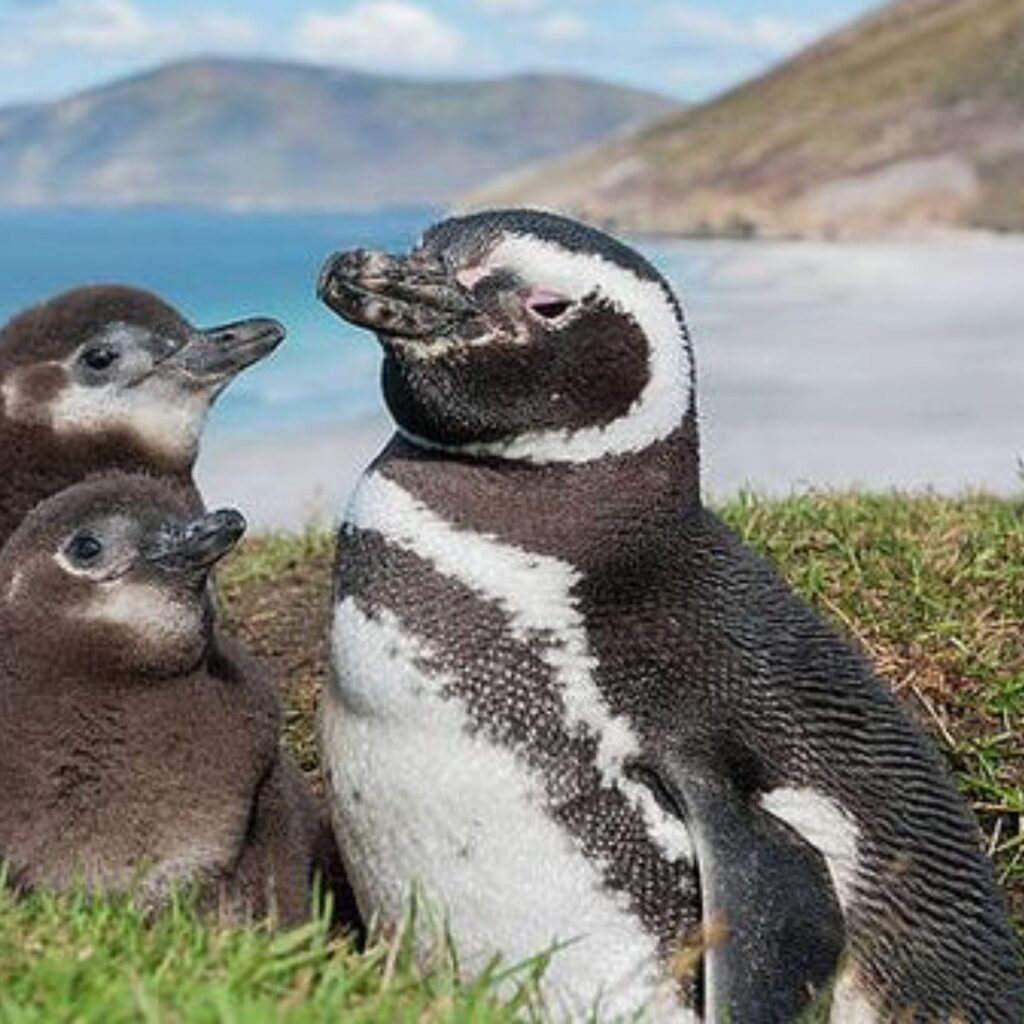
Magellanic penguins call the southern coasts of South America home. These charming, medium-sized penguins thrive in a unique region where land meets sea. Let’s explore the fascinating habitats of Magellanic penguins and discover what makes their homes special.
Also Read: Humboldt Penguin – Everything You Need to Know
Coastal Argentina: The Heart of Magellanic Territory
The largest populations of Magellanic penguins live along the Atlantic coast of Argentina. Here, you’ll find massive breeding colonies that can number in the hundreds of thousands. Some key locations include:
1. Punta Tombo: This protected area hosts the largest Magellanic penguin colony in the world.
2. Península Valdés: A UNESCO World Heritage site that provides crucial nesting grounds.
3. Cabo Dos Bahías: Another important breeding site for these penguins.
These areas offer rocky shores and beaches perfect for nesting and access to rich feeding grounds in the nearby waters.

Southern Chile: The Pacific Side
Magellanic penguins also inhabit the Pacific coast of southern Chile. While their numbers are smaller here, important colonies exist in places like:
1. Isla Magdalena: An island in the Strait of Magellan that hosts a large breeding colony.
2. Chiloé Island: Home to both nesting sites and year-round penguin residents.
The cold, nutrient-rich waters off Chile’s coast provide excellent hunting grounds for these skilled swimmers.
Falkland Islands (Islas Malvinas): An Island Paradise
The Falkland Islands host significant populations of Magellanic penguins. These remote islands offer:
1. Pristine beaches for nesting
2. Minimal land predators
3. Access to productive ocean waters
Magellanic penguins share these islands with other penguin species, creating diverse penguin communities.

Tierra del Fuego: The Southern Extreme
At the very tip of South America, Magellanic penguins inhabit the islands of Tierra del Fuego. This archipelago straddles both Argentina and Chile, offering:
1. Protected bays and inlets
2. Rich marine ecosystems
3. Cool temperatures ideal for penguins
Here, Magellanic penguins reach the southernmost part of their range.
Coastal Habitats: What Magellanic Penguins Need
Magellanic penguins require specific habitat features to thrive:
1. Sandy or pebbly beaches for nesting
2. Vegetation or natural shelters to protect nests
3. Easy access to the ocean for feeding
4. Cold, nutrient-rich waters that support their prey
They often dig burrows to nest, providing protection from harsh weather and predators.

Seasonal Movements: Not Just Homebodies
While Magellanic penguins return to their breeding colonies each year, they don’t stay in one place year-round. After breeding season, they embark on impressive journeys:
1. Some travel as far north as Brazil in search of food
2. Others move to the Pacific waters off Peru and Chile
3. These migrations can cover thousands of kilometers
This mobility helps Magellanic penguins adapt to changing ocean conditions and food availability.
Urban Neighbors: Adapting to Human Presence
In some areas, Magellanic penguin habitats overlap with human settlements. You might spot these birds near:
1. Fishing villages
2. Popular beaches
3. Even on the outskirts of coastal cities
This proximity to humans brings both challenges and opportunities for conservation.

Climate Change: Shifting Homes
Climate change affects where Magellanic penguins can live. Warming ocean temperatures force them to swim farther to find food. Some colonies have moved to adjust to these changes, showcasing the penguins’ adaptability but also highlighting the threats they face.
Protected Areas: Safeguarding Penguin Homes
Several protected areas exist within the Magellanic penguin’s range, including:
1. Punta Tombo Reserve, Argentina
2. Francisco Coloane Marine Park, Chile
3. Cabo Vírgenes Provincial Reserve, Argentina
These areas help protect critical habitats and provide opportunities for research and responsible ecotourism.

Why Their Habitat Matters
Understanding where Magellanic penguins live helps us protect them better. Their coastal and marine habitats face threats from overfishing, pollution, and climate change. By preserving these areas, we ensure a future for these charismatic birds and maintain the health of important marine ecosystems.
Also Read: The Humboldt Penguin: 11 Facts You Won’t Believe!
Visiting Magellanic Penguin Habitats
If you want to see Magellanic penguins in their natural home, several ecotourism options exist. Responsible wildlife viewing can support conservation efforts and local communities. Remember to follow guidelines to avoid disturbing the penguins or their habitat.
Magellanic penguins have adapted to a remarkable niche along the southern coasts of South America. Their homes showcase nature’s diversity and resilience. By learning about and protecting these habitats, we can help ensure these delightful birds continue to thrive in their unique corner of the world.
Pingback: 10 Fun Facts About Magellanic Penguins
Pingback: Humboldt Penguin vs Magellanic Penguin - Know The Difference